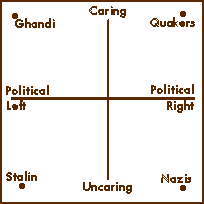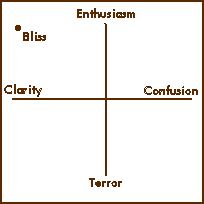Wisdom and Humanity's Transformational Dilemma
Some comments by Copthorne Macdonald on Anthony Judge's essay: "Imagining the Real Challenge"
As I have written
elsewhere, for the past 40 years Anthony Judge has closely observed
humanity's efforts to deal with its intertwined matrix of serious problems
— humanity's "problematique." He has written some 1300
essays and research papers and created the following databases, all
to shed light on how we might change things for the better.
World Problems - Issues: 56,564 profiles, 276,791 links
Global Strategies - Solutions: 32,547 profiles, 284,382 links
Human Values: 3,257 profiles, 119,255 links
Human Development: 4,817 profiles, 19,757 links
Patterns and Metaphors: 1,275 profiles, 4,535 links
Bibliography (issues): 16,579 profiles, 24,236 links
Integrative Concepts: 633 profiles, 0 links
Network Visualizations
In his essay "Imagining the Real Challenge" he uses words and unique graphics to present an exceptionally clear view of humanity's transformational dilemma. In my comments below I attempt to relate wisdom and its development to his insightful view of the situation.
Before
reading my comments, I suggest that you read at least to "Afterthoughts"
in Judge's essay:
Imagining the
Real Challenge
Several times in my intellectual life I have seen the explanatory power of two-dimensional, x-y displays. One I recall had Political Left and Political Right on the horizontal axis and human caring on the vertical axis, ranging from Uncaring at the bottom to highly Caring at the top. The Quakers were given a dot in the upper right corner, the Nazis one in the lower right. Stalin had a dot in the lower left corner, and I forget who they put in the upper left — perhaps Ghandi — but you get the idea. Another example. In one of my wisdom books I talk about trying to get across Joseph Campbell's concept of Bliss — as in "follow your bliss" — to a class of graduating high school seniors. My x-y chart had Clarity on the left of the x-axis and Confusion on the right. It had Enthusiasm at the top of the y-axis and Terror at the bottom. I put "The bliss place" in the upper left corner, and asked the students where they saw themselves on the chart as they faced life after graduation.


All that pales in explanatory power when compared with Figure 1 in Anthony Judge's "Imagining the Real Challenge." Adding the concepts of attractor and repulsor is akin to adding another dimension. In all, the figure, coupled with Judge's "Explanation," strikes me as a very powerful tool for conceptualizing the transformational dilemma that humanity faces.
Figure 1

I was immediately struck by how wisdom (and its absence) fits with his schema. Let us start with the Problematique, Resolutique, and the axis of explicit imaginary. In discussing the Problematique he points out the difficulty of "clarifying the extent and complexity of the problematique," and the power of "the pattern of habitual behaviours" to "resist change to another condition." He points out similar problems with the Resolutique: "Any proposed changes to conditions claimed to be more desirable are readily contested and framed as illusory and misleading." I see the role of wisdom in relation to this axis as helping to clarify the nature, extent, and complexity of both Problematique and Resolutique. A passage from Matters of Consequence:
Maslow studied people who had a high level of psychological development, “self–actualizing people” in his terminology. He studied the way these people perceived the world and the differences between their perceptions and those of most other people. He noted that for self–actualizing people (and others during self–actualizing moments), facts were value–laden; they had a certain “oughtness” and called for certain actions.
In Maslow’s words:
When anything is clear enough or certain enough, true enough, real enough, beyond the point of doubt, then that something raises within itself its own requiredness, its own demand–character, its own suitabilities. It “calls for” certain kinds of action rather than others. If we define ethics, morals, and values as guides to action, then the easiest and best guides to the most decisive actions are very facty facts; the more facty they are, the better guides to action they are.
We cannot, however, sense the oughtness of facts if we approach reality with anything less than a fully receptive, fully open mind:
If we wish to permit the facts to tell us their oughtness, we must learn to listen to them in a very specific way, which can be called Taoistic—silently, hushed, quietly, fully listening, noninterfering, receptive, patient, respectful of the matter–in–hand, courteous to the matter–in–hand.
The realization that facts, when deeply understood, can lead to right action is exciting. This approach facilitates ethically sound personal decision–making, and it also works on a societal scale. In both cases, if we see situations clearly enough, we know what to do. As we’ve seen, tens of millions of people in North America and elsewhere are now coming to understand themselves and their contextual reality more deeply. In the process, they are also seeing the inherent oughtness and requiredness in global situations, and are responding with specific actions.
Can ordinary folks develop the ability to do what Maslow's self-actualizers were doing? I believe they can. In Matters of Consequence I refer to this variety of wisdom as Deep Understanding:
Deep understanding combines breadth of intellectual knowledge with deep emotional/intuitional/spiritual knowledge—knowledge that involves perspective and identity, and therefore, is largely nonverbal and nonintellectual. Both types of knowledge are essential, and to develop both we need to adopt a two–pronged strategy: On the one hand, go outward and acquire relevant intellectual knowledge. On the other, go inward and find intuitive self–knowledge and a quiet mind.
On pages 300-303 of the book, and in Chapter 10 — Developing Deep Understanding, I present my thoughts on how one can engage in this development process in the context of understanding the human situation and becoming an effective change agent.
Let us assume that we managed to attain clarity about the nature, extent, and complexity of both Problematique and Resolutique. We still have those troublesome attractants on the other axis that are threatening to deflect humanity's progressive movement from Problematique to Resolutique. Wisdom again to the rescue. Let's return to Maslow; this time to his hierarchy-of-needs theory. The intensity of both the game-playing strategic drama and the self-esteem, megalomania, and neediness aspects of the psychodrama are related to one's developmental level in his hierarchy. If one has managed, psychologically, to move largely beyond Maslow's "deficiency needs," including the esteem needs, and into that realm of highly-developed humanness, or self-actualization, or wisdom — whatever we want to call it — then the strategic drama and psychodrama, the desire to play shady, bureaucratic, or self-esteem-connected games, have lost attractiveness to the individual, and thus their power to deflect.
The more complex chart, Figure 2, is also interesting. Here the primary axes of Figure 1 have been shifted 45 degrees counterclockwise so that the Explicit imaginary axis is now the y-axis. Interestingly, Judge has extended the y-axis beyond Resolutique and Problematique, and this makes sense.. Let's say we do manage to solve the world's problems (and our own personal ones). What is beyond that? What sort of personal lives and culture could we and should we anticipate? Much to imagine about. The same is true of the area below Problematique. The Problematique is the current problem matrix. But it is not the worst of all imaginable problem matrices. Some imagining devoted to possible types of worsening, and possible paths likely to lead to worsening, might be very worthwhile. He has also made changes to the x-axis, the Implicit real axis. At the right he has introduced Imaginatique, a personal reflective space that contains both positive and negative potentials.
Figure 2

Judge relates all this to two new axes, one labeled Reality-based governance, and the other Faith-based governance. We are all too familiar with the negative potentials (and realities) of faith-based governance, but it is interesting to think about the potential for a genuinely positive form of it. As yet we have no concrete examples of it, but Judge has mentioned the mythical archetype of the philosopher king, and the possibility of leadership by highly respected religious leaders — perhaps from the mystical branches of present world religions. In any event, he feels that we should not exclude the possibility.